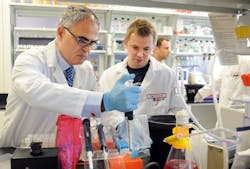Small Burners, Big Variety with 3D Printing
Euro-K uses EOS’ industrial 3D printing technology to build an innovative new micro-burner that can combust either gaseous or liquid fuels.
For centuries, a streamlined prow was believed to be the only practical shape for the front section of a boat hull. That changed when World War I naval architect, David Watson Taylor, invented the bulbous bow. That nose-shaped design allows the water to flow perfectly around the boat almost without any bow waves. A new shape therefore allowed a previously unimagined increase in efficiency. Energy converter service provider Euro-K experienced something similar with the construction of optimized burner geometry for gases and liquids when they turned to using Additive Manufacturing (AM) technology provided by EOS. With expertise in the field of small energy converters, Euro-K has a portfolio that ranges from advice on energy technology issues, including process analysis and optimization, to project planning, simulation, testing and production.A recent think-outside-the-prow-type challenge for the company was to develop and manufacture a multi-fuel burner—capable of using gaseous or liquid fuels—for the micro-gas turbines of a plant builder. A micro burner in action. Euro-K provides burner design, expertise in additive manufacturing, and also access to test rig technology such as pictured here. (Source: Faculty of Combustion Engines and Aircraft Propulsion, Prof. H. P. Berg, BTU Cottbus - Senftenberg)
